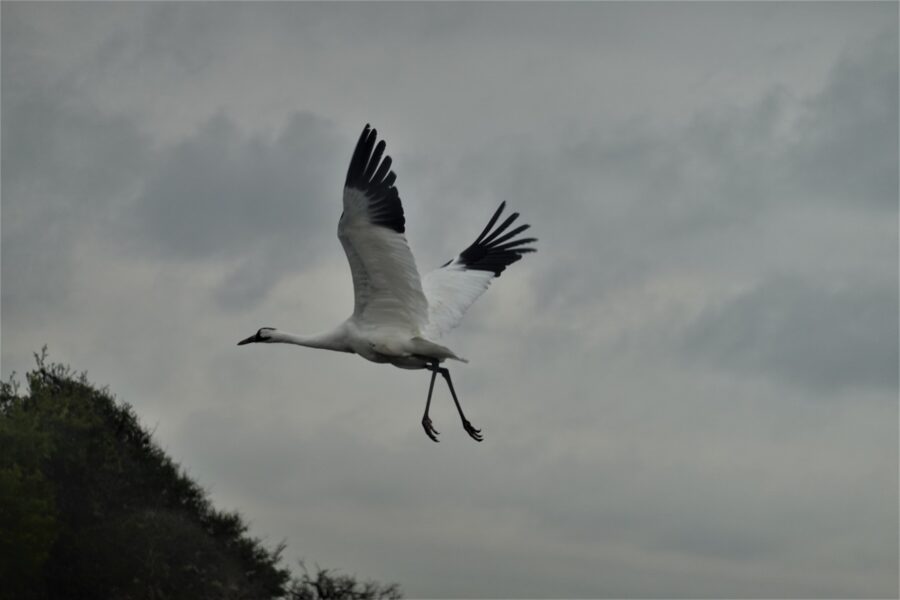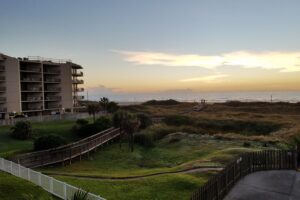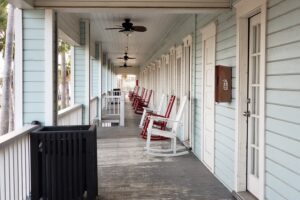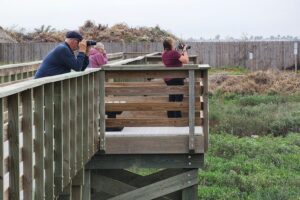Morning
It’s dark outside. The rain spatters. The wind roars. And—it’s COLD! I begin to wonder about our impending endangered Whooping Crane education on a boat we know nothing about other than its name—Skimmer. Envisioning one of the airboats used in the Everglades that easily glide across the marshy land—open air and exposed to the elements—I shiver at the thought. It is not an inviting prospect in this weather.
Pushing myself out of bed anyway and beginning the process of morning rituals, I shrug into something warmer and head for coffee and Michael. When I venture into the kitchen, Michael immediately tells me, “Don’t say a word, but I have already figured out what we’re going to do. We’re going to drive to Fulton, check in, and if the boat doesn’t have inside accommodations, we’ll leave.”
“But…”
“Not a word. I don’t want you to freeze for three hours.”
“I already know what to do—how to dress.”
“Not a word.”
Dressing for Success or at least Warmth
I drink my coffee, eat the breakfast taco put before me, and try to fully wake up. Thirty minutes before our departure time of 7:30 am, I walk to the bedroom and begin layering. By the time I am finally dressed in jeans, thick socks, tennis shoes, a thin tight-fitting shirt, a halfway bulky pullover sweater, and a bulky sweatshirt, I can barely get my arms through my too-thin all-weather coat. When finally I succeed, I feel like a scarecrow with arms permanently extended.
Michael helps me get my layers of clothing somewhat straightened out, and I add a very warm neck scarf to my attire. I’m missing a hat and gloves, and there’s a reason. I hadn’t planned on a coastal birding adventure on a boat when I packed for this trip.
I leave my purse behind, put my multi-purpose phone in my pocket, and waddle out the door to the conveniently placed 6th-floor elevator. While waiting for the door to open, Michael tells me he will get the car, bring it around and pick me up, so I don’t have to brave the elements just yet.
“You are being way too gallant,” I say.
“I know,” he replies.
Destination Fulton Whooping Crane Tours




This morning the ferry lines are nearly nonexistent, and we make it to Rockport, a stone’s throw from Fulton, almost an hour early, so Michael decides to drive along the harbor docks and survey the shrimp fleet and bait stands whose eye-catching flags flap wildly. I am reminded of a book I used to read my children every year in honor of our impending culinary feast, Cranberry Thanksgiving. It opened with the line, “…and the wind was cold at the edge of the sea.” Now I know…



Once in Fulton, Michael walks through the open door of Rockport Birding and Kayak Adventures to check on the status of our Whooping Crane tour. The rules are pretty explicit—the tour company requires a minimum of 10 people; the trip can be canceled if the winds are too high. Rain doesn’t matter. Cold weather doesn’t matter. If you paid—it is the tour company’s money no matter what—you just need to reschedule; still, Michael handed me his credit card to make $285 reservations on my phone, online, during our 4-hour trip through South Texas.
Michael comes back with a smile on his face. The trip is on; they have an enclosed cabin with coffee and hot chocolate onboard. We leave in 20 minutes.


The Skimmer
Standing in line, waiting to board the Skimmer for our Whooping Crane tour, the Captain walks down the gangway, saying loudly, “It will be another 30 minutes. I need to go pick up some tools for a needed repair.” To me this sounds a tiny bit ominous. I know boats—we have a history—a long history beginning during my childhood. I keep my trepidation to myself.
We are offered the shelter of a tent with picnic tables and wildly flapping canvas in which to wait. In unison, sixteen heavily clad individuals turn and head for their automobiles—warmth and comfortable seating is a stronger lure.
Aransas Wildlife Refuge



Finally, on board the Skimmer, we seemingly fly across Aransas Bay toward the Aransas National Wildlife Refuge in search of the endangered Whooping Crane. Traveling at speeds high enough to make the bow of the boat point skyward and with the doorway into the cabin open wide, I am surprisingly comfortable. We must be traveling with the wind because there is not a whisper of a breeze invading our space. Salt spray coats the age-scarred windows beside us. Occasionally we stop as the Captain points out via a loudspeaker various species of birds floating in the water, perched on rocks, gathered on small islands, or winging their way across the heavens.
With the salt spray spattered, scarred glass windows beside me, I can’t see a thing. But I have seen these feathered sea birds before, years ago during the summers of Island Rose, when we sailed the Intracoastal Waterway as often as possible and I discovered why the phrase birds of a feather flock together, exists. I smile and remember those birds.
The Whooping Crane
When we reach the Wildlife Refuge, thirty minutes into our three-hour trip, we spot our first Whooping Cranes, and my education begins. The Whooping Crane is the tallest of North America’s birds, reaching a height of close to 5 feet with a 7 to 8-foot wing span, and the worldwide population is barely 600 hundred.


Because of hunting and habitat loss, the Whooping Crane population dropped to only 15 by 1941. These cranes all belonged to one flock that migrated between Wood Buffalo National Park in Canada and the Aransas National Wildlife Refuge in Texas. Conservationists intervened, working with local, federal, and international governments to protect the flock and encourage breeding. Today, the only self-sustaining population of the Whooping Crane is the naturally occurring flock that breeds in Canada and winters in Texas. About 440 of these cranes live in the wild, and 160 are in captivity.



The three Whooping Cranes before us, that began my ornithological education, consists of one adult and two juveniles. The adults are pure white with black-tipped wings and a red face—the youngsters are a splotchy rusty color. I learn that by the time they make their annual summer trek to Canada, only their heads will be sandy-colored.



For two hours, we stop and start and stalk and photograph and learn.












Leave a Reply
Your email is safe with us.